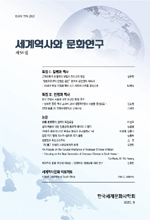보스의 <쾌락의 정원>과 르네상스 - 단테 『신곡』의 관련성을 중심으로
Bosch’s <The Garden of Earthly Delights> and Renaissance : Focusing on the relevance of Dante’s Divine Comedy
- 한국세계문화사학회
- 세계역사와 문화연구
- 제72집
-
2024.09273 - 301 (29 pages)
-
DOI : 10.32961/jwhc.2024.09.72.273
- 67

이 연구는 히에로니무스 보스의 <쾌락의 정원>(1503-4)에 나타난 르네상스 특성을 단테 『신곡』(1320)과의 관련성을 중심으로 규명해, 중세와 르네상스의 공존이라는 이 작품의 온전한 역사적 의미를 재구성하려 했다. <쾌락의 정원>은 주제로 ‘음욕’에 대한 경고를 내세우고 있는 점에서 그동안 중세의 범주 안에서만 거론되었다. 그러나 작품 속 작가의 자화상은 단테가 처음으로 제기한 나에 대한 자각이라는 르네상스 특성이다. 이에 따라 이글은 <쾌락의 정원>에 대한 논의를 르네상스로 확장해, 단테의 『신곡』 「지옥」과의 관련성을 중심으로 살펴보았다. 보스가 중세의 범주에서 더 나아가 새로운 시대정신을 담고자 한 이유는 근본적으로 인간과 인간을 둘러싼 세계에 대한 지극한 관심이었다. 고통의 한복판에 자리 잡고 있지만, 인간의 삶은 계속되어야 한다는 르네상스 휴머니즘의 세계관이 그것이다. 이런 점에서 <쾌락의 정원>의 르네상스적 특성은 역사적 의미를 답보한다고 볼 수 있다.
This study attempted to reconstruct the full historical meaning of this work, which is the coexistence of the Middle Ages and the Renaissance, by examining the Renaissance characteristics shown in Hieronymus Bosch’s <The Garden of Earthly Delights> (1503-4) with a focus on its relationship with Dante’s Divine Comedy (1320). <The Garden of Earthly Delights> has been discussed only within the scope of the Middle Ages because its theme warns against ‘lust’. However, the Bosch’s self-portrait in the work is a Renaissance characteristic of self-awareness, which Dante first raised. Accordingly, this article expanded the discussion of <The Garden of Earthly Delights> to the Renaissance, focusing on its relationship with Dante’s Divine Comedy’s “Inferno”. The reason Bosch wanted to go beyond the scope of the Middle Ages and include a new zeitgeist was fundamentally his extreme interest in humans and the world surrounding humans. This is the worldview of Renaissance humanism, which holds that human life must continue even though it is located in the midst of suffering. In this respect, the Renaissance characteristics of <The Garden of Earthly Delights> can be seen as recapturing historical significance.
Ⅰ. 들어가는 말
Ⅱ. 16세기 초 네덜란드의 상황과 보스
Ⅲ. 쾌락의 정원과 『신곡』 「지옥」
Ⅳ. 맺는말
(0)
(0)